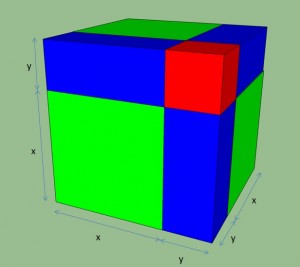Well, I hope that the pictures in my last post changed the way you look at the square of a binomial. And I am sure that I know what you are thinking now:
“What about binomials, cubed?”
We can figure this out algebraically. You may be inspired to see that:
(x + y)3 = (x + y)(x + y)2 = (x + y)(x2 + 2xy + y2)
And then we distribute:
(x + y)(x2 + 2xy + y2) =
x(x2 + 2xy + y2) + y(x2 + 2xy + y2) =
x3 +2x2y + xy2 + x2y + 2xy2 + y3
And then you group the common terms to discover the rule for the cube of a binomial.
(x + y)3 = x3 + 3x2y + 3xy2 + y3
Let me just say that you have a rare appreciation for algebra if that equation by itself stirs you. And I would not be shocked to find that you skipped over the algebra that led to it. But once again, it’s better with pictures.
This time, we build a cube with each edge x + y units long:
Then, we take that cube apart and see what we have:
Let’s take inventory. The big cube we started with has been broken up into the following collection:
- A white cube with edge length x and volume x3
- A red cube with edge length y and volume y3
- 3 green rectangular slabs, dimensions x by x by y, with volume x2y
- 3 skinny blue rectangular solids, dimensions y by y by x, with volume xy2
But the volume of the collection has to add up to the volume of the big cube we started with.
That means: (x + y)3 = x3 + 3x2y + 3xy2 + y3 !
The 3-d picture makes this equation worthy of an exclamation point. The picture helps you to “see” the equation. That can also work the other way around. Let’s consider a 4-dimensional “hypercube” with edges that are (x + y). I can’t picture those. But I can still get some insight about them from the algebraic approach. I’ll skip the steps this time and go right to the result:
(x + y)4 = x4 + 4x3y + 6x2y2 + 4xy3 + y4
Even though I can’t picture a 4-dimensional cube, I think I know what happens when you break it into pieces: you get 1 big hypercube, 1 smaller hyper cube and a variety of hyper-rectangular solids. You can predict the dimensions and the number of each type from the equation above. So I guess this time, it’s better with equations.
(The graphics in this post were created in Google Sketch-up by my daughter.)


